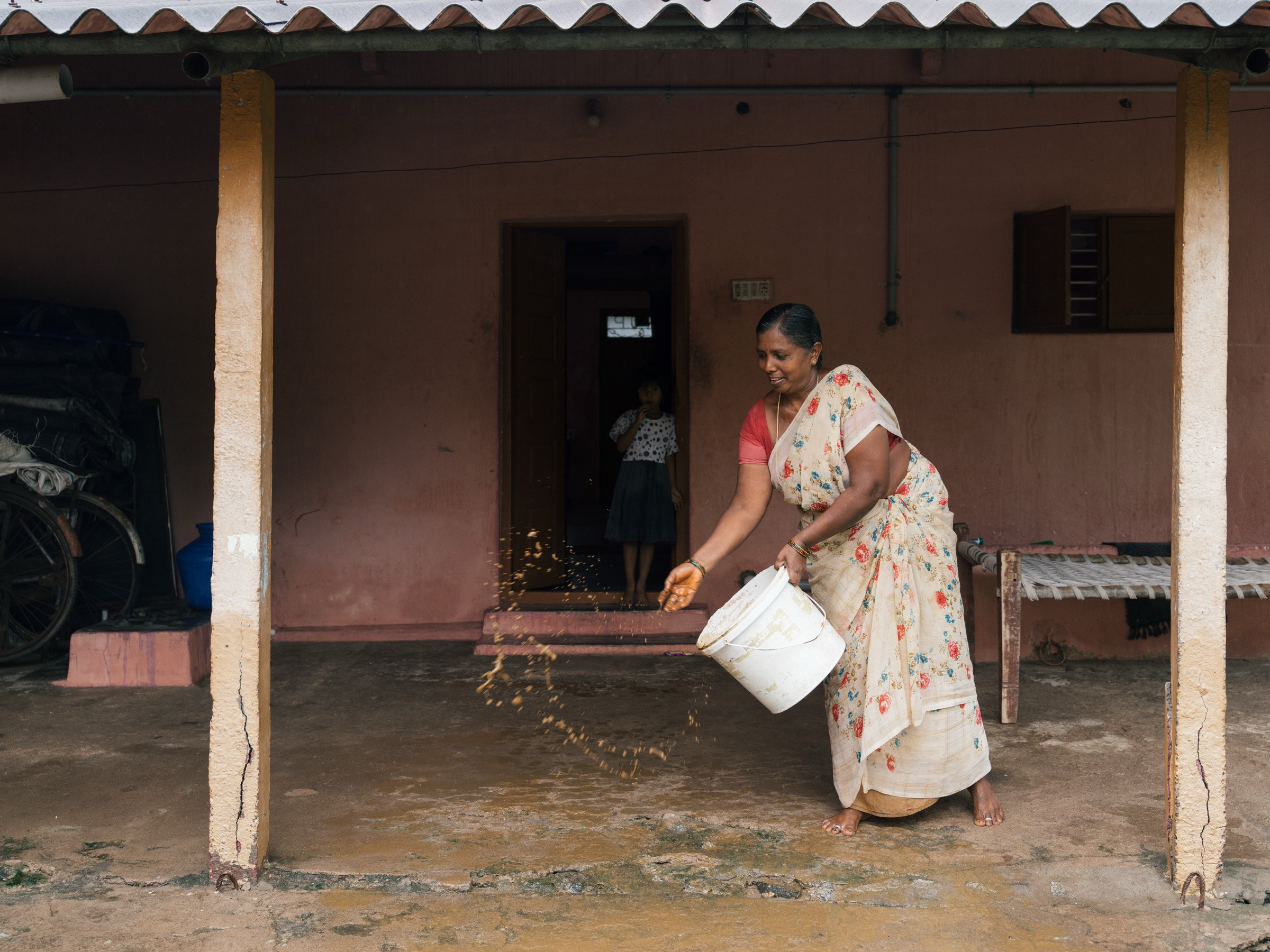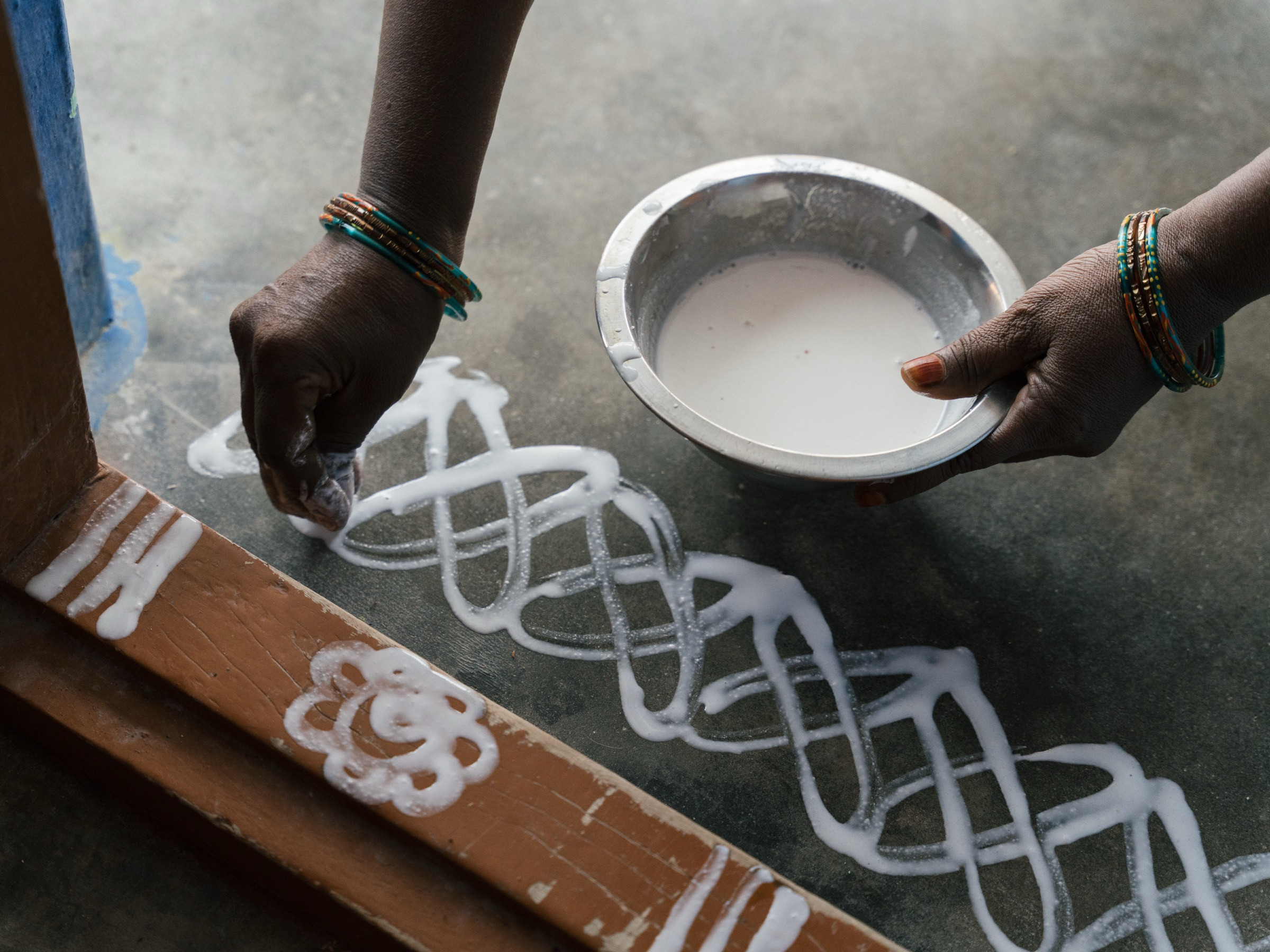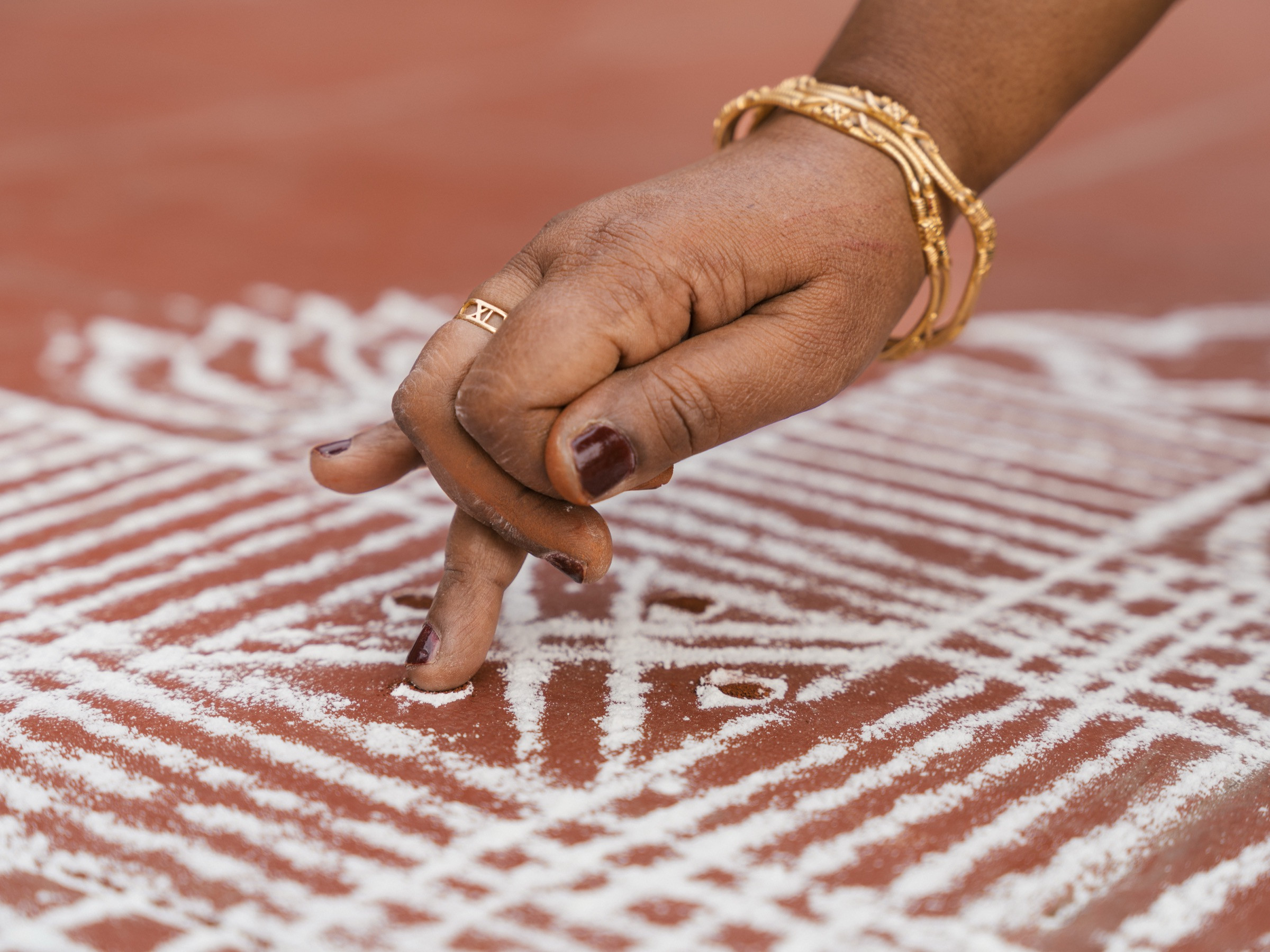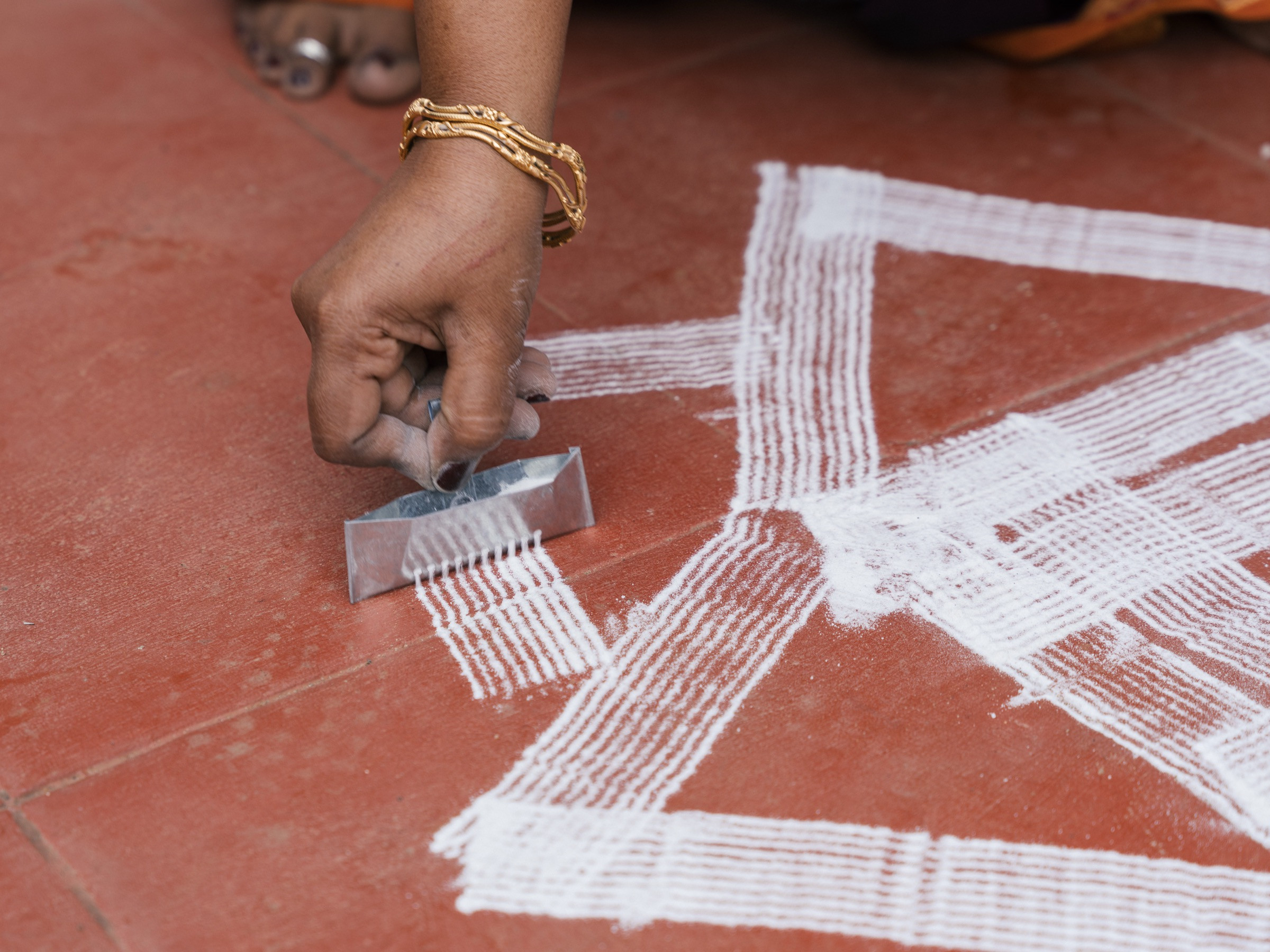The word cold is not something that one would associate with the city of Chennai. Yet, when the Tamil month of Margazhi rolls in on December 16th, a tender breeze envelopes the mornings, nudging it away from its usual muggy heat. Margazhi is welcomed with the sweetness of akkaravadisal — a heavenly medley of rice and lentils cooked in milk and sugar or jaggery, the comfort of venn pongal — its savoury partner, and most importantly, a large kōlam — a decorative floor art, typically made with rice flour, at the threshold of a home.
Multiple messages
Creating a kōlam usually involves cleaning the floor, and then creating patterns with rice flour, using quick, deft movements of the hand. As the powder leaves the tiny space between the fingers, it lands on the floor in dots, lines or circles , forming designs that range between simple and highly intricate. Sometimes, these designs are also highlighted by an outline using red brick powder. In rural areas, a slurry of cow dung and water is often smeared on the floor before drawing the kōlam. While this acts as an antiseptic (thereby keeping diseases at bay), it also provides a mild green backdrop for the design. Although most kōlams are made using dry rice flour, they are sometimes made with a wet paste, and are called maa or maavu kōlam.
In Tamil, the word kōlam means beauty, play, design and disguise. The practice of drawing a kōlam is not only unique to Tamil Nadu, but is created across the country in different names and forms. Whether it is announcing the well-being of the household (the lack of a kōlam indicates that the women could not draw one for various reasons, or that the family is in mourning), celebrating an auspicious month, or following a simple ritual to set the tone for the day, kōlams are multifaceted and serve various purposes.
A world within itself
While it may seem like there are millions of patterns to choose from, kōlams do come with their own set of categories and rules. Broadly, everyday kōlams are classified into dot-based or puli kōlams and square-based or katta kōlams. Sometimes, they are also classified as kodu or line kōlams and pulli kōlams. However, several sub-categories exist within this format, based on how the dots, lines and shapes interact. Kōlams have now also evolved to include freehand versions where the artists let their creativity take the lead as opposed to dots, lines and geometric patterns.
Bound by symmetry
“Symmetry is a fundamental necessity here and makes the pattern in a kōlam. It could be any form of symmetry: XY, mirror, radial or diagonal symmetry, all of which work. It's like the grammar of kōlam," says Bhargavii Mani, Designer and Founder of the Kolam Podu Shop. The complexity of these designs and their patterns have made kōlams a subject of study not only among practitioners and designers, but also among mathematicians, anthropologists, computer scientists and psychologists. But it is in kōlam's adherence to symmetry that we see one of its most primal links to nature.
"Look around and you will see how nature celebrates symmetry," says Mani. Beyond obvious patterns of symmetry seen in leaves, butterflies and flowers, a 2022 study by researchers at Oxford University stated that nature has a bias towards 'simple structural symmetry'. The study revealed that even small biological structures like protein molecules and RNA prefer this route of simplicity and symmetry.
Symbolism plays a vital role in a kolam pattern – an elephant head signifies Lord Ganesh being asked to remove an obstacle, while a snake pattern is believed to remove the evil eye. The serpentine motions of a sikku kōlam (‘sikku’ refers to knots or problems), is a message to address the problem at the doorstep, says Mani. In the olden days, the presence of a complex sikku kōlam meant there was an educated woman in the family.
Beyond symbolism, other motifs that represent flowers, birds, leaves and other natural elements, stand as a subtle reminder of the natural world that surrounds us. For example, during Pongal, kōlams with motifs like sugarcane, the sun and a pot brimming with food are drawn to show abundance and bountiful harvests. With the evolution of the art, kōlams today are also drawn to convey messages of conservation such as ‘Save Trees’ or ‘Protect Mother Earth’.
Acceptance and apology
Dr Vijaya Nagarajan, of University of San Francisco, explains in her book, Feeding a Thousand Souls: Women, Ritual, and Ecology in India - An Exploration of the Kōlam, that kōlams are mainly drawn to usher in wealth and prosperity, and prevent misfortune and bad luck from entering the household.
However, one of the most important reasons for the kōlam’s existence is to absolve one of the consequences of negative acts by figuratively ‘feeding a thousand souls’. The rice flour in the art form is exposed to birds, ants and insects throughout the day. As most people do not have resources to feed a thousand others, the kōlam intercedes as a means to carry out this sacrifice right at one’s doorstep, explains Nagarajan.
While this seems specific to the person drawing the kōlam, Nagarajan shares that kōlams are also meant to offset some of the invisible destructions that humans often cause around them. Through her reading of Manusmriti, Nagarjan realised that the act of sacrificing food is meant to atone for the countless animal homes that human beings end up destroying while setting up their abodes. Further, the treatise states that while using tools like the broom, grinding stone and hearth, several visible and invisible creatures are harmed. “Kōlam drawing, therefore, alleviates the karmic debt of the individual and the household,” she explains.
Moreover, kōlam is also a means to seek forgiveness from the Earth Goddess, Bhūdevi. As one interviewee tells Nagarajan – “We Walk on her. We spit on her, we poke her, we burden her. We expect her to bear us and put up with all the activities we do on her with endless patience.”
The future of dots and lines
When Copenhagen-based food designer and visual artist Priya Mani thinks of kōlam making, she immediately connects the art to the three women who have profoundly impacted her understanding of it. Her mother, who draws elaborate kōlams in a full-scape notebook but resorts to simpler versions for her daily use. Her aunt, who uses the limited space outside her doorstep to make the most of the matrix and draw traditional kōlams, and her father’s sister, who abandons all rules to draw free-hand kōlams and express her creativity.
“As I immersed myself in design and began working with motifs and imagery, I realised that even the simple kōlams that my mother draws regularly have a deep sense of symbolism. To master them is akin to mastering the recipe of rasam, which requires just a few ingredients, but nine out of ten rasams are not memorable. Even a simple kōlam design requires attention to detail and regular practice,” she says.
Her mother’s full-scape notebook stands as testimony to a time when kōlams were learnt on scraps of paper and through kōlam books. Today, several YouTube channels and Instagram accounts dedicate themselves to the art form. Ironically, all of this is happening as the daily practice of drawing a kōlam is slowly fading and apartment doorsteps are often adorned with maroon stickers that are embellished with a kōlam design.
Beyond the art form itself, the elements of kōlam-making have also changed. “Even for the wet rice flour kōlam, someone shared that you can use a slurry of Fevicol and cornflour to create a design that will last a few days. On many levels, it serves the new evolving need for permanence in the impermanence,” says Mani.
So where does the kōlam go from here? On the Kolam Podu Shop website, Bhargavii Mani and her team are making the art form more accessible to the new-age practitioner by sharing smaller designs for our compact living spaces and introducing books that celebrate drawing kōlams. Having launched ten books, the team is working on launching 24 more, especially for children, so they can use the art to think creatively and develop problem-solving capabilities. “Kōlams teach critical thinking, focus, patience and aid in improving neuroplasticity. Through games, colouring books and more, we are hoping that people will appreciate the true value of this unique art,” says Mani.
Today, as kōlams slowly recede from an everyday ritual to one marked for special occasions, Nagarajan echoes the sentiments of an astrologer she met in Madurai, one of the few men who contributed to her understanding of the kōlam. “I remember he said to me, Vijaya, kōlam is not just about beauty. You will do a great disservice to the kōlam if you don’t tie the ethics to aesthetics. And I think that is what is important at this point in time. Unless the kōlam is restored to its full capacity of storytelling that comes with the ritual, it fails to be an everyday reminder that we stand on the Earth along with so many other beings. That Bhūdevi is right there beneath our feet.”
*Edited by Sheema Mookherjee
*kōlam artists: 1. Jayanthi, Lakshmi Vinoth & Viji Shekar


















